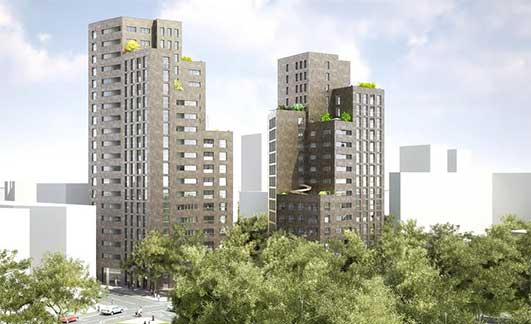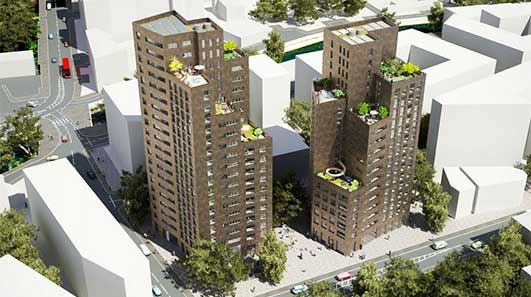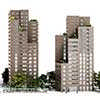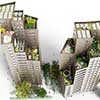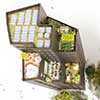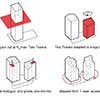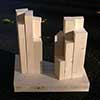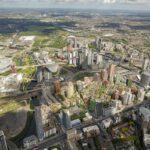Colville Estate Buildings, Hackney Homes, London Residential Design, England Architecture, Architect
Colville Estate Towers : Hackney Housing
Residential Development in north east London – design by NL Architects + WHAT Architecture
27 Feb 2013
Columnar Towers in Hackney
Design: NL Architects + WHAT Architecture
Colville Estate, Hackney, London, England
Hackney Housing
Columnar Towers is a proposal for a residential development of 199 apartments in Hackney, London. The project is part of a masterplan by Karakusevic Carson Architects for the regeneration of the Colville Estate.
The high residential density demands of the project brief will inevitably result in large massing. Our proposal attempts to mitigate the effects of this by breaking each tower into a ‘bundle’ of seven smaller towers, or ‘columns’. Each mini-tower is formed by simple ‘stacks’ of single apartments.
Two towers were required with a different footprint and of different heights; one with six and the other with 5 apartments per floor. This precondition however forces the entire complex to be relatively tall.
By increasing the number of units to seven per floor at the base, the opportunity is created to modify the figure. More apartments in the lower section allow for a reduction of apartments in the higher areas: both buildings now get more slender towards the top.
A ‘vertical dialogue’ is established between the columns: one grows, one shrinks…
The stepped morphology that emerges helps integrate the building mass into the urban fabric. The different heights of the columns correspond with the height of buildings in the surroundings.
In anticipation to the irregular geometry of the masterplan the plan of the Columnar Towers is intricate too, kind of star-shaped, each facet accentuating the columnar arrangement.
Each individual mini-tower is further defined through fenestration changes, creating a constantly changing formal rhythm to the two towers. In a way the project is an instant skyline wrapped around a building.
In order to optimize the proposal as a whole one layout has been developed that could be duplicated; Twin Towers are in principle cost-effective.
To avoid visual repetition each tower footprint has been rotated 90 relative to each other. This twist, in combination with the star-plan and the stepped shape creates individual and distinctive forms. The simple trick works very well: it is quite deceptive, but the two towers are actually clones.
In increasingly dense urban environments pleasant outdoor space gets ever more important. The often unexploited neutrality of regular flat rooftops is here charged by dissolving the mass: the different heights of the ‘columns’ create rooftops on different altitudes that can be used as collective terraces; the ‘sky gardens’ will be a common, private amenity for residents.
The terraces can have different orientations, different views, different functionalities: barbeque, outdoor lounge, breakfast or high tea, ping pong, trampoline, kiddy pool or Dutch Tub. Outdoor gym + shower? Allotment garden, urban farming, giant zucchini?
The public realm between the towers is open so access from the park directly to the new interior street of the master plan is now possible.
All apartments have a recessed balcony, creating an external room that can be used at any time of year, sheltered from the wind and rain. All apartments with more than one bedroom are dual aspect.
The dwellings are designed for modern, flexible city living incorporating the concept of ‘living walls’. These provide space for vertical services distribution up the building, wet spaces and storage. The internal circulation within apartments always terminates in an external view. Views open up, creating a better quality of internal space.
The structure is intended in so-called cross-laminated timber (CLT), stretching the limits of this material to the next level. CLT is a strong, lightweight material, made from a European white wood such as spruce. Like plywood, CLT consists of layers of boards glued in alternate directions. CLT forms an environmentally friendly alternative to steel or concrete.
Off-site prefabrication which CLT allows reduces the build programme considerably, producing not only lower build costs but better detailing and performance, as panels are cut from CAD information as well as a reduction of annoyance for the neighbors during construction.
Colville Estate Hackney – Building Information
Project: Columnar Towers, Colville Estate, Hackney, London, invited competition 2012
Client: Hackney Council
NL Architects + WHAT Architecture
Pieter Bannenberg, Walter van Dijk, Kamiel Klaasse + Anthony Hoete
Team NL: Guus Peters, Bobby de Graaf, Gen Yamamoto, Paul Ducom, Phil Wilson, Soo-Kyung Chun, Yinglin Cao, Paulo Dos Souza, Giulia Pastore, Jan Szymankiewicz, Matthew Davis
Team WHAT: Anthony Hoete, Magdalena Szerla, Jan-Carlos Kucharek, Catarina Bio, Petra Kubelcova, Mitsuru Yamamori, Camille Favre, Cesar Cordoba, Aleksandra Jarodzka, Karl Lenton
Consultants: Arup: David Gilpin, Nigel Annereau Techniker: Matthew Wells, Tom Robertshaw
Colville Estate Housing, Hackney images / information from NL Architects + WHAT Architecture
NL Architects + WHAT Architecture
Location: Colville Estate, Hackney, London, England, UK
London Buildings
Contemporary London Building Designs
London Architecture Links – chronological list
London Architecture Tours by e-architect
London Housing
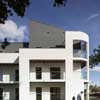
photo © Tim Crocker
Adelaide Wharf

photograph © Tim Soar
Hackney Housing
Fraser Brown MacKenna Architects
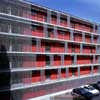
photograph : James Morris
Pembury Estate Hackney
Comments / photos for the Colville Estate homes : Columnar Towers Hackney – New Homes in East London page welcome

